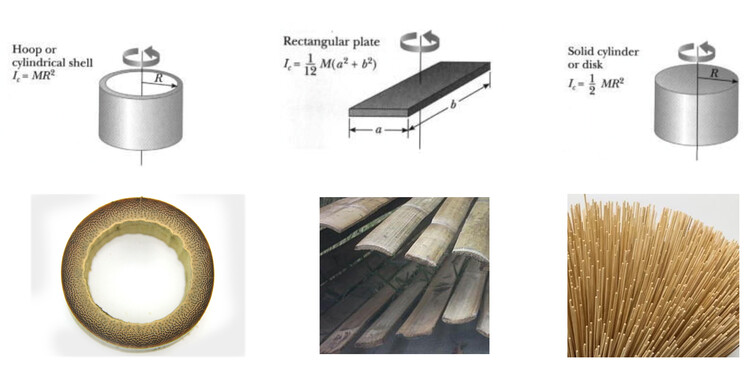
Bamboo has endless possibilities and when combined with creativity, it can lead to a wide range of interesting shapes. In its natural form, it is a straight, slightly tapering pole. But how do we bend it to create fluid, dynamic spaces? Bamboo is naturally flexible and can be flexed into a slight bend and simple framed structures can be built using bamboo’s natural straight form.
However, it requires specific techniques to achieve extensive curvilinear forms. In the structures we build here in Bali, there are 3 techniques to create curved structures using bamboo. These are:
- Rup Rup
- Split Members
- Lidi Bundles

Before learning to bend bamboo we need to understand the moment of inertia of different cross-sections of the type of material we use for these techniques.
In a simpler way, a smaller surface area and solid form will have more flexibility compared to a hollow cylindrical form. Full poles have less flexibility than splits and splits have less flexibility than lidi bundles (full poles < splits < lidi).
For the rup-rup technique, we use full-round pole bamboo in its natural form. For the split members technique we use bamboo splits which are wide and flat rectangular shaped slats and for lidi bundles, we also use bamboo splits which are thinner and in a solid cylindrical form.
1. Rup-Rup

Shaping and curving whole, hollow bamboo poles in their natural form is challenging because of their cylindrical profile but it can be done using the rup-rup technique. This is a process where v-shaped cuts are made along the axis of the bamboo pole wherever it is necessary to achieve the shape we require.

It is important to note that this cutting of the wall culm reduces the structural integrity of the full poles to only the part that has not been cut, which is just a split. For structural members to maintain structural integrity, we bundle two or more full-bamboo poles together as per our requirement. We bolt them together with threaded rods and bamboo pins to ensure there is no moment in the bundle.

This technique is used to make elements like structural arches, ridge members for roofs, furniture, and decorative elements like railings. Dendrocalamus asper locally known as Bambu petung and Gigantochloa apus locally known as Bambu tali are commonly used for the structural elements and Bambusa Blumeana locally known as Bambu duri for furniture and decorative elements.

The new Green School Bali gym designed by IBUKU is the largest arched structure in bamboo of its kind in the world and is composed of 18 arches, which are built on the ground using the rup-rup technique. They have bundled 6 Dendrocalamus asper poles to achieve structural integrity according to the design.
Mepantigan auditorium and Turtle classroom, also at the Green School, designed by IBUKU are some other examples of structures built using the rup-rup technique.
2. Splits

Bamboo laths or splits are made by splitting full bamboo into strips. Splits have been used traditionally in a wide range of products. We have been experimenting with building using splits in various applications. Very strong and lightweight structures can be built using bamboo’s best property “tensile strength” with splits. Splits have freedom in bending and the arching systems can be shaped easily.

For some structural members to have structural integrity, we use a clump of bamboo splits tied together called a split bundle. The elements are assembled on the ground using templates and installed into place easily. Dendrocalamus Asper splits are used for structural elements and Gigantochloa Apus for non-structural elements. The splits are glues together, the split bundles are pinned together with bamboo pins in opposing angles to ensure there is no moment in the bundle.


To know more about a typology of how to build with bamboo splits check out our Pool hang-out pods article, and River bend house at Bambu Indah article.
3. Lidi Bundles

Lidi bundles are hand whittled thin, long, and solid circular bamboo sticks bundled together. The result is a curved and flexible element that is adjustable in shape, dimension, and length.

The flexibility of lidi bundles complements the organic and curvilinear roofing structures more beautifully and artistically. Sharma Springs, a six-level bamboo residence designed by IBUKU, is one of the best buildings that exhibits the use of the lidi bundle.
Lidi bundles are tied together on the ground by hand and tightened by metal clamps to ensure they are tightly held together. The bundle is carried to site and installed in place using vertical supports. Lidi bundles need to be bound together carefully, paying special attention to each strip’s individual placement. Lidi bundles are used to make both structural and decorative elements.

This article was originally published here by Bamboo U, a bamboo architecture and design enterprise that focuses on sharing sustainable ways of building. Bamboo courses are available on their campus in Bali, Indonesia, and Online, lead in collaboration with the renowned design firm IBUKU and bamboo experts from around the world. From growing bamboo to treatment methods, bamboo design and model making, engineering, carpentry, and construction: their workshops cover all there is to know about bamboo building and design. Find out more & join a bamboo workshop here.


















